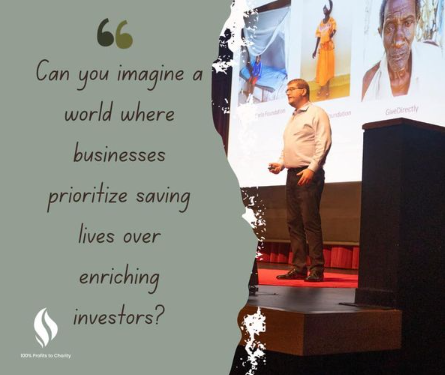In our most recent newsletter, we announced that The Life You Can Save can now accept donations in over 40 types of cryptocurrencies. Crypto donations quickly started coming in and we want to say thank you to the donors responsible, including @worldofumans and @spirit_swap and whoever anonymously donated 3 ETH.
We’ve also received a number of questions about why we’ve decided to prioritize crypto, and how we think about crypto’s environmental impact. I’ll try to answer those questions in this post. But first, I want to make an exciting new announcement that illustrates some of the opportunities we see in crypto!
Crypto For Good: A fundraiser for GiveDirectly
[December 2022 Update: We’ve considered removing this blog post from our site when FTX and Alameda collapsed. After discussing internally, we decided it would be more honest to keep it up. Obviously, in retrospect, it was a mistake to involve Sam Bankman-Fried and Caroline Ellison in this event (like many others, we were fooled by them), but we felt like removing the post would be akin to covering up, rather than acknowledging that mistake. The Life You Can Save has never received any money from Sam Bankman-Fried, Caroline Ellison, FTX, or Alameda.]
On December 2, some of the biggest names in crypto joined our founder Peter Singer in an online discussion about how crypto-philanthropy can fight poverty. The other panelists were Sam Bankman-Fried (founder and CEO of FTX, and the world’s richest person under 30), Caitlin Long (founder and CEO of Avanti), Haseeb Qureshi (managing director at Dragonfly), and Sibongani Kayola (Liberia country director for GiveDirectly). Rhys Lindmark (co-founder of Roote) and Laura Shin (host of Unchained and Unconfirmed podcasts) moderated the event and then reposted it on their podcasts. All proceeds went to support GiveDirectly.
We hope this event raised a lot of awareness for GiveDirectly, The Life You Can Save, and the arguments for effective giving in the crypto community.
This What Good Is Crypto? fundraiser raised over $920,000 for GiveDirectly. This will provide Universal Basic Income for over 2700 Liberians living in poverty. We’re grateful to FTX and Haseeb Qureshi for providing matching funds, and to everyone else who contributed. If you missed the discussion, we hope you’ll review the transcript of this inspirational event to learn more about how you can use crypto for good.

Frequently asked questions about crypto
Q: Why is crypto a strategic fit for The Life You Can Save?
A: Earlier this year we made a decision to prioritize crypto donations. These are the main reasons why we thought the crypto market was a good strategic fit for us:
- Our strategy emphasizes raising funds from high net worth (HNW) donors, and the crypto community has a disproportionate and growing number of HNW individuals. A recent Bloomberg article on crypto-philanthropy quoted Coinbase CEO Brian Armstrong’s observation that “If the price of Bitcoin were to reach $200,000 half of the world’s billionaires would be crypto billionaires.”
- If we act as an intermediary that can accept crypto donations on behalf of any of our recommended nonprofits, they can all get the benefits of receiving crypto without each organization having to invest in building and maintaining the capacity to do so themselves. It’s a more efficient process for everyone.
- Crypto is still relatively new, so much of the wealth the industry has generated is the sort of “newfound wealth” that people are more likely to donate (relative to other sources of wealth). Also, crypto’s tax treatment in the U.S. can often make it more efficient for donors to give crypto rather than other sorts of assets. If these or other reasons drive people to donate crypto, we want to be able to facilitate that giving as part of our “smart giving simplified” brand.
- Our crypto donation process is powered by The Giving Block, an organization that specializes in crypto-philanthropy. Working with The Giving Block means we’re listed on their site, which is the main place crypto donors go to give. This allows us to reach a much larger audience than we’d ever be able to reach on our own.
- The effective giving message seems to resonate well with the crypto community, including some high-profile members. Examples include Vitalik Buterin (Ethereum co-founder) giving $54 million in Ethereum to GiveWell and Jack Dorsey (CEO of Twitter and Square) donating the $2.5 million proceeds from selling his first tweet as a non-fungible token to GiveDirectly. We would love to help build a norm of effective giving as this community grows.
Putting all these factors together, we see an enormous opportunity in crypto. And we’re excited to announce a new event that will help us take advantage of that opportunity.
Q: Are you concerned about crypto’s environmental impact?
A: Some cryptocurrencies, most notably Bitcoin, utilize an energy-intensive “Proof-of-Work” approach to validate their networks, while others use “Proof-of-Stake” validation methods that are much less energy intensive. While energy usage is one difference between these two approaches, there are other trade-offs between Proof-of-Work and Proof-of-Stake that The Life You Can Save is not well-positioned to evaluate. (As a point of clarity, individual crypto transactions including any crypto donations we receive are not themselves energy intensive. Rather, Proof-of-Work systems expend energy conducting “mining” operations that secure the network.)
At The Life You Can Save, we focus on making it easy for people to donate to effective charities that help the global poor, including providing a range of popular donation payment options. With the rising popularity of crypto donations – and considering the fact that the process of donating crypto is not energy-intensive – we believe that the benefits of offering people the choice of donating crypto significantly outweighs any drawbacks. Please refer to our Gift Acceptance Policy for more details on our policies around accepting different types of gifts.
We also want to acknowledge that crypto’s environmental impact is a complex and rapidly evolving topic that we are not experts in. The Fugue Foundation, a supporter of ours that also promotes blockchain technology, has written about some of the complexities involved.
Q: What does The Life You Can Save do with cryptocurrencies it receives as donations?
A: Whenever we receive a crypto donation, it is immediately converted into dollars by The Giving Block (the platform that powers our crypto giving). This allows us to avoid exposure to fluctuations in the price of various cryptos, and makes it easier to transfer the money to our recommended nonprofits.



